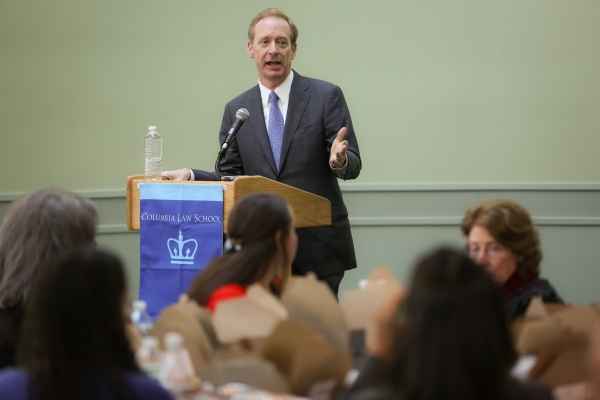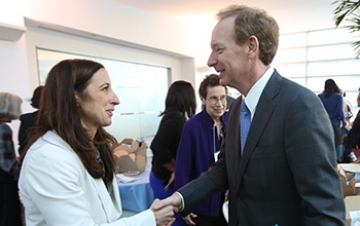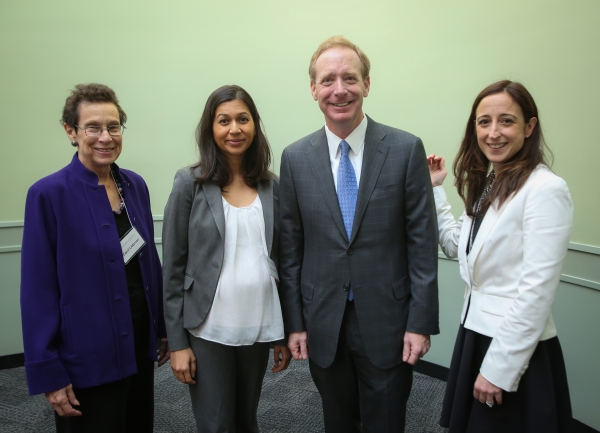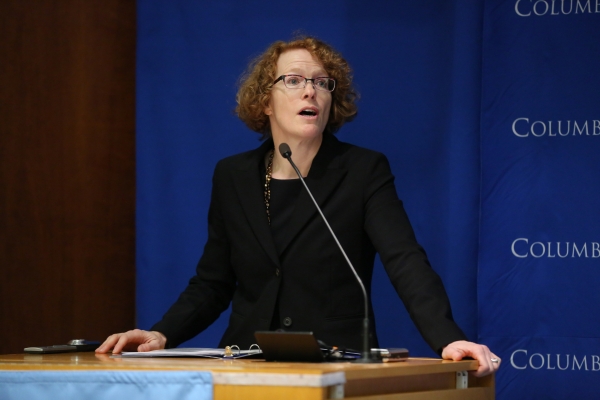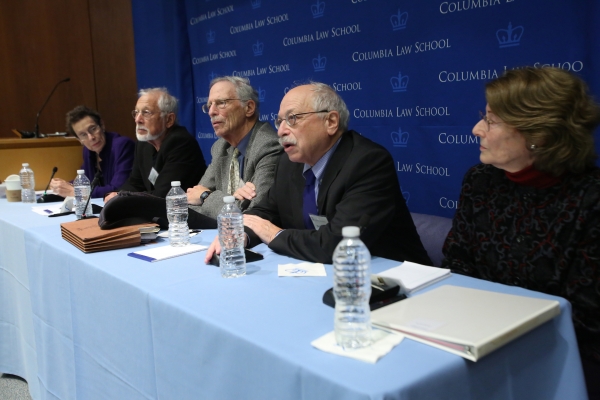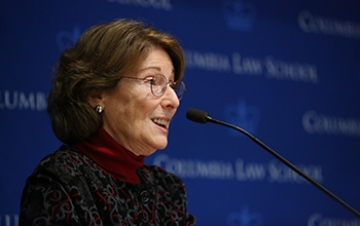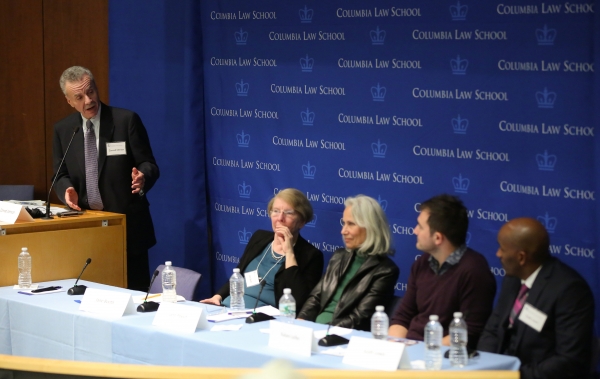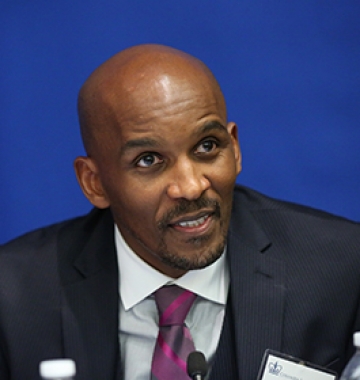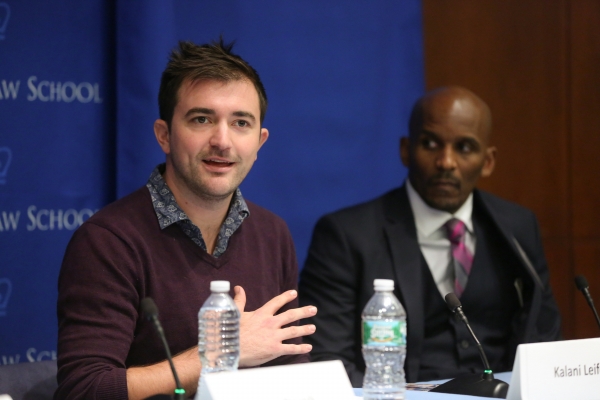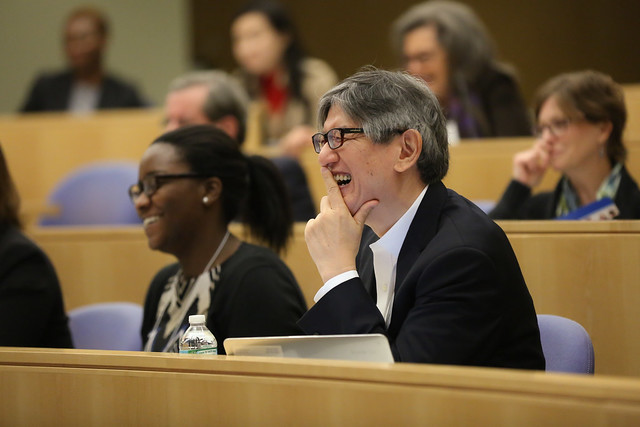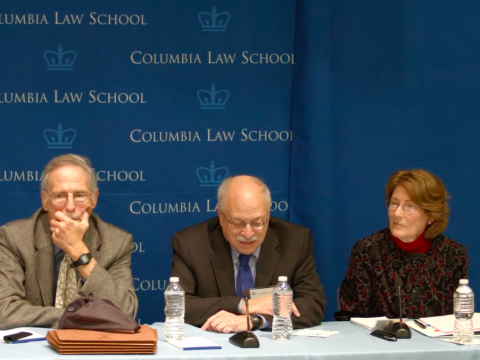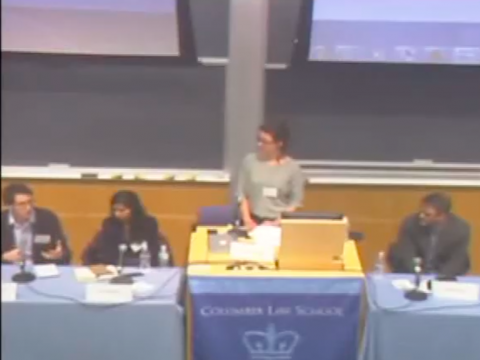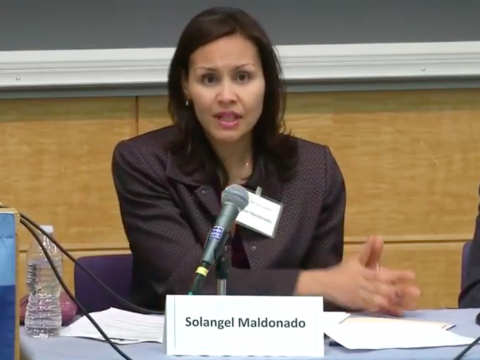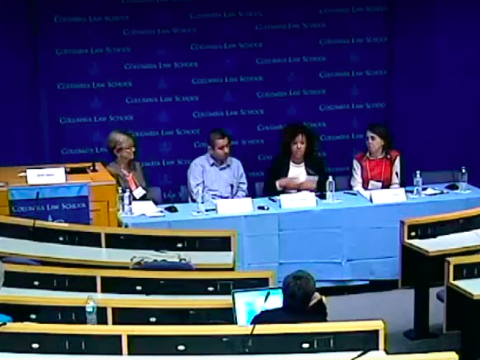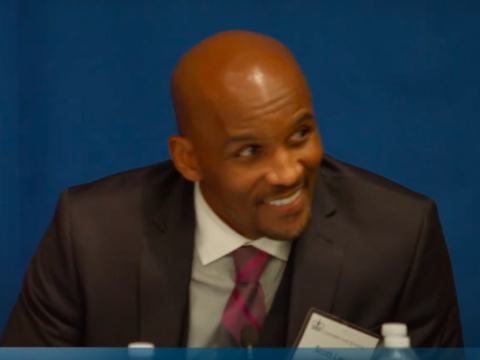Origins and Innovations: A Celebration of Clinics
Alumni, clinical faculty, and students gathered to discuss current issues, share clinical experiences, and learn about the future of clinical legal education.
Keynote Speaker
Bradford L. Smith '84, President and Chief Legal Officer, Microsoft Corporation
As a student at Columbia Law School three decades ago, Bradford Smith ’84 spent one semester working in the Immigration Law Clinic, where he represented low-income clients facing deportation. In a speech at Columbia Law School delivered on Nov. 13, Smith said that experience proved invaluable—it shaped his life’s work.
“Law school is where you learn to think like a lawyer,” said Smith, now the president and chief legal officer at Microsoft, the multinational technology corporation based in Redmond, Washington. “But it’s clinical education that really teaches you to act like a lawyer.”
Smith was the keynote speaker at a daylong conference, “Origins and Innovations: A Celebration of Clinics at Columbia Law School,” marking 45 years of clinical legal education at the Law School. A pioneer in clinical education, Columbia Law School now provides free legal services at 10 student clinics covering a range of subject areas—from adolescent representation to environmental law to mass incarceration to sexuality and gender. At these clinics, students learn the law and lawyering in context, working with real clients under the close supervision of clinical professors.
Smith’s remarks were introduced by Gillian Lester, Dean and the Lucy G. Moses Professor of Law: “We all hold Brad up as the type of graduate that Columbia Law School seeks to train, aspires to create, and prepares to practice,” she said, describing Smith as “one of our most distinguished and high-achieving alumni.” Lester praised “the spirit of innovation” Smith brings to his current job, leading a team of 1,300 business and legal professionals in 55 countries, as well as his extensive involvement in pro bono services and other philanthropic work.
In addition to overseeing Microsoft’s corporate philanthropy and social responsibility initiatives, Smith chairs the Leadership Council on Legal Diversity and the Washington State Opportunity Scholarship program, an appointment by the governor. He co-founded and co-chairs one of the nation’s largest pro bono efforts, Kids in Need of Defense (KIND), which represents unaccompanied children in U.S. immigration courts. Since its beginnings in 2007, KIND has trained more than 6,000 pro bono lawyers (and currently represents approximately 1,500 clients). In that time, the number of unaccompanied minors has exploded. “We last year saw 60,000 people come into the United States from Central America, seeking to stay here and needing a lawyer,” Smith said. His co-founder and co-chair at KIND is the United Nations high commissioner for refugees special envoy, actress and filmmaker Angelina Jolie.
“It just goes to show that, when you pay attention in clinical education at Columbia, you never know who you might find yourself working with in the future,” Smith said.
With his wife, attorney Kathy Surace-Smith ’84 who is also an alumna of the Immigration Law Clinic, he has established the Smith Family Opportunity Scholarship, which assists students from lesser-developed countries at Columbia Law School.
When Smith related his story at the November 13 conference, he said it all began in the Immigrants’ Rights Clinic, then taught by Columbia Law School professors Harriet Rabb and Lucas Guttentag. More specifically, he explained, it started with his first client. That’s when he learned “to listen like a lawyer.”
“He was a young man, about the same age as myself, who was facing deportation,” recalled Smith. “We quickly realized, not surprisingly, that this case was a big deal to him. It was all about whether he was going to be able to continue to hold his job, live in this city, and stay in this country. For someone who didn’t yet have a law degree, and certainly didn’t yet have a license to practice law, these were pretty high stakes.
“If we were going to do our job well, we needed to listen to him; we needed to understand his issues; we needed to be able to work with him to mold the case that we would put forward. We needed to do our best to help him succeed. It brought home that, fundamentally, work as a lawyer is all about serving a client.”
At Microsoft, Smith oversees lawyers in the largest corporate immigration practice in the country. “We’re responsible for keeping in the United States 12,000 employees and their 15,000 dependents—their spouses, their children, in some cases their parents—so every day we’re responsible not for one person, but for 27,000 people.”
As America grows into an ever more diverse nation, Smith believes lawyers need to do more to “understand the needs of the individuals that we serve” and to “build the diversity of the profession in order to serve the diversity of the country.
“Right now, less than 9 percent of the nation’s lawyers are African-American or Latino, and yet we live in a country where more than 30 percent of our population is African-American or Latino,” he said. “The legal profession is less diverse than the nation’s doctors. It’s less diverse than the nation’s accountants. It’s less diverse than the nation’s engineers. It is less diverse than the nation’s business graduates. There is only one profession that is less diverse than law, and that is dentistry.
“We have a lot of people who are different from ourselves that we need to serve. One of the great things about clinical education is the same thing I see in pro bono work. If you are representing a real person in a clinic, by definition you are almost certainly serving a client who cannot afford a lawyer. And yet most lawyers, especially lawyers who have gone to Columbia Law School, can afford a lawyer if they need one. That means we are connecting with people who in some important respects are different from ourselves and we need to be good at understanding their needs and listening to them and working with them, something that I think we get started on in the context of clinical education.”
Smith praised young people today for their sense of justice. “They are passionate about social justice, and they are impatient about the rate of change. They know that we can do better as a country. And yet, interestingly, at the same time we all recognize that law school applications have declined. Why is it that, at a time when people are so passionate about justice, fewer people are applying to law school?
“I think there is a message that we have the opportunity to deliver to the college students and other young people of this country: If you care about justice, you should think about law school, because at the end of the day there can be no justice without law. There can be no lawyers doing something to move justice forward unless they come to law school.”
Smith addressed the students in the audience: “I hope you can take this message forward and encourage others to come here, get involved, take a clinic, take more than one. Use this to change the world. Just as I learned in the clinic that being a lawyer was all about serving a client, I think we need to always remember that, fundamentally, the role of lawyers is to serve the country.”
Panels
History in the Making: Four Pioneers Trace the Origins of Clinical Education at Columbia Law School
Four groundbreaking legal educators returned to Columbia Law School recently as panelists to discuss one of the nation’s first clinical law programs. Their stories related a larger battle to change legal education at America’s law schools.
The panel discussion was the first session in a daylong conference, “Origins and Innovations: A Celebration of Clinics at Columbia Law School,” marking 45 years of clinical legal education. By teaching the law and lawyering in context, 10 Columbia Law School clinics continue to answer an often-desperate need for legal services and to cultivate the skills required for students to thrive in the practice of law.
The November 13 conference began with remarks by Alexandra Carter ’03, the director of clinical programs at the Law School (and a “proud alum” of the Mediation Clinic), and Dean Gillian Lester, the Lucy G. Moses Professor of Law.
“The development of clinics at Columbia Law School was a true breakthrough in legal education,” Lester said. “I can’t overstate this point. Clinics provided a laboratory for students to explore the practical aspects and the challenges of lawyering.
“Since those early clinics were established nearly five decades ago, Columbia’s clinical programs have continued to lead the way forward, and to do so at the highest levels of excellence and innovation. Not only have we established first-of-their-kind clinics in a number of cutting-edge areas—HIV/AIDS, gender and sexuality, the digital age—we continue to recruit clinicians of the highest caliber, all while staying true to the original mission of providing students with real-world experience,” she said.
A Breakthrough in Legal Education
The “founding four” clinicians were introduced by conference organizer Carol B. Liebman, a clinical professor at Columbia Law School who shortly after joining the faculty in 1992 co-founded the Mediation Clinic—which was among the first clinics on this subject in the nation. “But George Cooper really is the founding father” of clinical offerings at Columbia, Liebman said.
Cooper, who taught at the Law School from 1966 to 1985, had been hired as a tax specialist. “Dean [William] Warren thought I would help build a super tax department at Columbia,” he recalled. “He did not understand that he had hired a mole. Despite my tax expertise, what I really wanted to be was a civil rights lawyer and a reformer. But I had no idea I was going to participate in any curricular reform.”
His timing turned out to be fortuitous. “By 1968, the country was on fire,” said Cooper. Eight days before the assassination of Martin Luther King, Jr., Columbia students began to protest a University plan to build a multistory athletic facility in Morningside Park. Student protests mixed antiwar activists with opponents of the gymnasium.
“Because the University was taking part of a city park, they cut a deal to build a small gym at the bottom of the hill for the community,” Cooper said. “The symbolism of this—a big gym for us at the top of the hill, a little gym for you at the bottom—did not seem to be in the awareness of the Columbia administration, particularly the three-piece-suited Grayson Kirk, who was then president.” After an eight-day, five-building takeover by students, Kirk was eased out. “Efforts to repair relations with the community were now on the front burner,” said Cooper.
Cooper saw an opportunity to provide legal services to those living in the Harlem community. “We also wanted to reform legal education,” Cooper said. “Legal education was still stuck in an 1880s model of large classes and Socratic case-method dialogue. Nobody would suggest that for skills training. Medical schools had known [about the benefits of clinical instruction] for decades; it was time for law schools to move into the 20th century.”
Michael I. Sovern ’55, currently the Law School’s Chancellor Kent Professor of Law and president emeritus of Columbia University, had just been named the dean of Columbia Law School. “He was a true believer and a big supporter of reform,” said Cooper. “The stars were aligned, and when we submitted a formal proposal to create the Columbia Legal Assistance Resource in 1969, no member of the faculty—not even the most conservative—wanted to go on record opposing it.”
Michael Meltsner was the first clinician hired by Cooper in 1970. A graduate of Yale Law School, Meltsner ran Columbia’s first poverty law clinic. He had been an attorney with the NAACP Legal Defense and Educational Fund, where he worked on cases that led to the integration of Southern hospitals and the Supreme Court’s 1972 moratorium on the death penalty. He also represented Mohammad Ali in the lawsuit that allowed the boxer to return to the ring after refusing to serve in the military. From 1979 until 1984, Meltsner served as the dean of Northeastern University Law School.
“Clinical legal education was forcing a deeply ideological divide in law schools,” Meltsner said. “I still remember the skepticism of some on the faculty. They didn’t really know what we were doing.”
And, in some cases, neither did the clinicians. While Meltsner admits to, in some instances, “making it up as we went along,” he also fondly recalls “the pleasure and the novelty that the first clinicians brought to legal education.”
“After all of these years, I still remember the excitement of working with the people on this stage, and the students were truly remarkable, as demonstrated by the incredible, brilliant careers they’ve had,” Meltsner said. “When we started, there were less than 50 clinical law teachers in the United States. When I looked at the [Association of American Law Schools] directory last year, I counted 1,452.”
The third member of the “founding four,” Philip G. Schrag, now directs Georgetown’s Center for Applied Legal Studies. He had been an attorney with Meltsner at the NAACP’s Legal Defense Fund, and he would later work for the Carter administration as deputy general counsel of the U.S. Arms Control and Disarmament Agency. Schrag noted that the Ford Foundation was an overlooked player in the development of clinical legal education at Columbia Law School and elsewhere. “Over a 10-year period, through a Ford spin-off called CLEPR, the Council on Legal Education for Professional Responsibility, the foundation gave $11 million to law schools to create clinical programs,” said Schrag, whose recollections then took the form of rhyming couplets:
“They knew how to change things in a flash. / All they had to do was offer cash.” Cooper “went to CLEPR for its funding cycle. / Within a year, his faculty had Michael. / I came next, while CLEPR paid the tab. / Columbia kept going, adding Rabb.”
(Read Philip G. Schrag's entire poem titled, “45 years of Clinical Education on Morningside Heights.”)
At Cooper’s invitation, Harriet S. Rabb ’66 joined the clinical program at Columbia Law School in 1971 and taught the Law School’s clinical seminar on fair employment law with him. “I later co-taught that clinic with Howard Rubin ’72,” she said. “For many years, we were a great team. The cases we brought were largely class actions for working women.”
In 1972 Rabb became the assistant dean of urban affairs, the first woman dean at Columbia Law School. “Earlier that same year, the first woman, Ruth Bader Ginsburg ’59, and the first African-American, Kellis Parker, became members of the Law School faculty. Things at Columbia were going to change.”
Significant Class-action Lawsuits
In bringing class-action discrimination suits against employers, Rabb was portrayed in the press as “the notorious radical feminist whiz-kid and conqueror of corporate giants,” said Liebman, reading from one account. “So the Notorious RBG has nothing on Harriet. But Harriet’s not only a conqueror—she’s also a builder. She co-founded and co-directed five different clinical offerings: The Employment Rights Project, the Big Apple Clinic, the Immigration Law Clinic, the Education Law Project, and the Fair Housing Clinic. She presided over the growth of clinics at Columbia for 20 years, before leaving to be general counsel of HHS in the Clinton administration, and she’s currently vice president and general counsel at Rockefeller University.”
Rabb took obvious delight in recalling the clinics’ significant achievements. She recounted a 1972 discrimination case involving 50 women at Newsweek magazine. “The settlement one year later secured management’s commitment to hiring and assigning goals and the appointment of a woman to editorial management,” she said. “We’re lucky to have the lead plaintiff here.” That plaintiff, Lynn Povich, recently wrote a book about the Columbia case, The Good Girls Revolt: How the Women of Newsweek Sued Their Bosses and Changed the Workplace. Her book is now being turned into a streaming television series on Amazon.
Another 1972 case was filed by the clinical students and Rabb on behalf of 2,200 women employed by the New York Telephone Company. “Women held 98 percent of the lowest management jobs, while men held 80 percent of the top management jobs,” said Rabb. The company settled the following year. One of the named plaintiffs, Jane E. Booth ’76, managed hundreds of telephone operators, but her supervisor told her that women were not cut out for higher management positions. “Jane did well,” Rabb pointed out. “She is currently the general counsel of Columbia University.”
In 1971, Rabb and her students focused on discriminatory hiring practices at New York City’s biggest law firms. “The 50 largest law firms employed 3,900 lawyers; 161 of those lawyers were women,” Rabb said. “Of 1,400 partners in those firms, nine were women.” Women law students at Columbia and NYU decided to record their job interviews and bring suit, if necessary. “We settled most of our claims, but then we took two of the firms to federal court.” Those two firms eventually settled, too, in 1974 and 1977. Rabb recalled two other successful clinic class actions filed by women at Reader’s Digest and The New York Times.
“All these cases engaged students in every aspect of litigation, except for appearing in court as counsel for the plaintiff class,” Rabb said. Other clinics, she noted, were different: Students in the Immigration Law and Fair Housing clinics did it all, counseling their clients and representing them at administrative hearings. Students participating in the Education Law Project researched and drafted papers that were delivered to policy makers.
“When I left Columbia Law School to go into the federal government, the clinical program was wonderfully staffed, offering a wide variety of modes of operation and addressing a wide set of issues,” Rabb said. “Clinical colleagues were finally recognized and well-regarded for their role in our students’ education. So almost a quarter-century of clinical experimentation had proven important to the Law School—and immensely, personally important and rewarding for all of us because of our student colleagues, who taught us as we taught them.”
Clinics from the Perspective of Those We Serve
A Personal Perspective: Clinic Clients—Past and Current—Share Moving Stories of the Vital Contributions Clinical Faculty and Students Have Made to Their Lives
For Scott T. Lewis, Columbia Law School’s clinics meant the difference between life and death. Wrongfully incarcerated for 19 years for a double murder that occurred in the early 1990s, Lewis worked with the Mass Incarceration Clinic, directed by Professor Brett Dignam, to prove his innocence in court and clear his name.
“I was swimming in 3,000 feet of water alone for about 10 years of my incarceration, as I made the decision to represent myself,” he said at a recent celebration of 45 years of clinical education at the Law School. “If I had the opportunity to change the school’s name, it would be ‘Champions of Justice.’”
Lewis, who was originally sentenced to 120 years in prison but was released from jail on the determination of a federal judge in 2014, now serves as a law clerk for the Connecticut Innocence Project, a branch of the state’s Division of Public Defender Services that works to exonerate those who are wrongly convicted of crimes. He was one of four former clinic clients who shared their experiences during the daylong celebration on November 13 that brought generations of clinical faculty and alumni to Jerome Greene Hall.
During the afternoon discussion, “Clinics from the Perspective of Those We Serve,” Columbia University General Counsel Jane Booth ’76, author Lynn Povich, and nonprofit start-up founder Kalani Leifer joined Lewis in describing how professors, students, and staff members helped them to break barriers and overcome seemingly insurmountable challenges. The conversation was moderated by Professor Conrad Johnson, co-director of the Lawyering in the Digital Age Clinic, and director of Clinical Education from 1992 to 1996.
“I always talk, when I talk about my legal career, about how I was driven by luck,” said Booth, an alumna and a former client of Professor Harriet Rabb ’66, who taught the Law School’s clinical seminar on fair employment law. Booth was working as a low-level manager at New York Telephone when Rabb asked to join a gender discrimination lawsuit against the company in 1971. “But the luckiest day was the day I became a clinic client.”
Initially reluctant to join the suit, Booth had a change of heart after she was told during a management assessment that it was a shame she was not a man. “If you were male, you could be anything in this company,” the adviser said.
“What was such a hard decision was now an easy decision,” Booth recollected. “I called Harriet and said, ‘Count me in.’” A month after the case was successfully settled, Booth began her legal studies at the Law School. She went on to serve as chief of the civil division in the office of the U.S. Attorney for the Southern District of New York, among many other high-ranking jobs, before becoming general counsel of the University in 2009.
Povich, the first female senior editor at Newsweek, was also part of a gender discrimination case spearheaded by one of the Law School’s clinics. After filing suit against the news magazine in the early 1970s, and subsequently settling for a memorandum of understanding that called for Newsweek to hire and promote more women, Povich and her co-plaintiffs realized little had changed. They turned to Columbia Law School, specifically Rabb and Professor George Cooper, a civil rights law specialist who co-directed the Law School’s clinical programming on fair employment law and served on the faculty from 1966 to 1985.
With assistance from students, Povich and her co-plaintiffs were educated on how to build a stronger case. Rabb—who currently serves as vice president and general counsel of Rockefeller University—led the complicated negotiations, challenging hiring practices that were inherently subjective. Eventually, Newsweek management conceded to all of the plaintiffs’ requests.
“My life, my colleagues’ lives, and so many women’s lives were changed because of this Columbia clinic,” said Povich, who wrote about the experience in her 2012 book, The Good Girls Revolt.
Leifer, executive director and founder of CO*OP, a nonprofit organization that works to overcome underemployment for graduates of the City University of New York system, had an equally fulfilling experience with the Law School’s clinics. As a start-up founder, he approached the Community Enterprise Clinic in 2014 for help creating bylaws and applying for the organization’s 501(c)(3) certification. The guidance he received encompassed all facets of creating his new initiative.
“The students not only helped us navigate all the standard questions we had as a start-up nonprofit,” Leifer said when recounting the myriad ways clinic participants assisted him in creating his business.
“They maybe got into this experience thinking they would be my legal counsel, which they definitely were. But in many ways they were also my co-founders,” he added.
The panelists all agreed that the Law School’s clinical programming has had a profound impact, both in shaping society over nearly five decades and on improving lives and livelihoods so dependent on legal outcomes. No one appreciates the contributions more acutely than Lewis, who applauded the clinics’ client-centered approach and discussed how Dignam and her students were the first to treat him like a human being, not just a case. He told students in the audience to always remember that they have been given the privilege and the opportunity to make a difference.
“What the clinic means to me is life,” Lewis said. “It has given me a second chance at life that many thought would never come my way.”
Photos of the Day
Catch the moments of the daylong conference celebrating 45 years of clinical legal education at Columbia Law School
